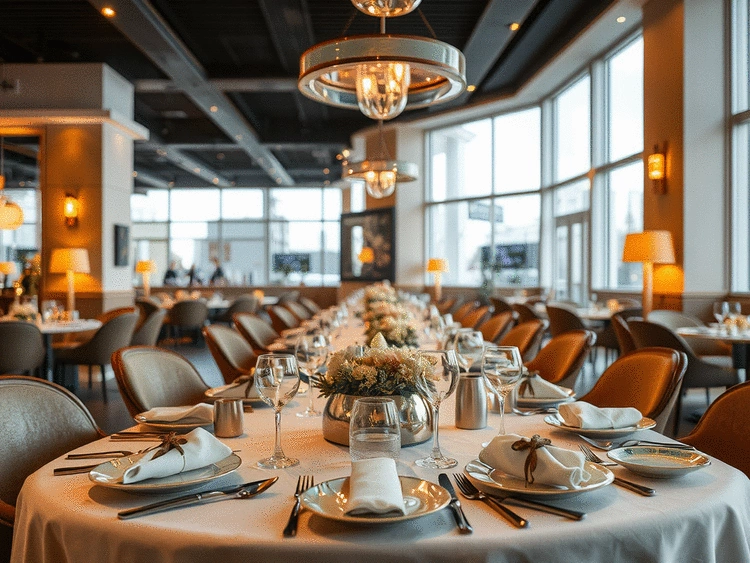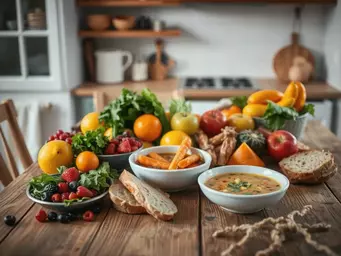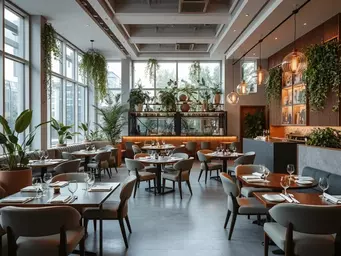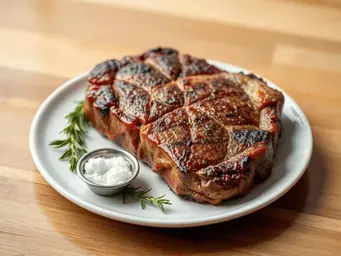Research indicates that the environment in which we dine can profoundly shape our culinary experience. As we dive into the intricate relationship between restaurant design and customer satisfaction, you'll discover how every detail contributes to memorable dining moments. Let's explore the key insights that can transform how restaurateurs think about their space.
What You Will Learn
- First Impressions Matter: The entrance and exterior design set the tone for the entire dining experience.
- Emotional Connections: Thoughtfully designed spaces can evoke personal memories, enhancing meal enjoyment.
- Influence on Taste Perception: Surroundings can impact how we perceive flavors, making aesthetics a vital consideration.
- Key Design Factors: Elements like lighting, color schemes, and layout significantly shape customer satisfaction.
- Trends in Design: The future of restaurant architecture leans towards sustainability and flexible, customer-centered spaces.
The Impact of Restaurant Design on Dining Experience
Restaurant architecture significantly influences customer perception and satisfaction. The elements below highlight how design shapes our emotional and sensory journey in a culinary space.
Why Design Matters for Customer Satisfaction
- First Impressions set the tone.
- Emotional Connection with the space.
- Comfort Levels enhance enjoyment.
How Architecture Shapes Taste Perception
- Visual Appeal enhances flavor perception.
- Acoustics contribute to sensory experience.
- Comfortable Spaces create positive associations.
Key Interior Design Factors
- Lighting sets the mood.
- Color Schemes stimulate appetite.
- Layout influences interaction.
- Ambience includes sounds & scents.
Practical Applications for Restaurateurs
- Adjustable lighting for flexibility.
- Color schemes reflecting cuisine.
- Layouts for social interaction.
- Strategic use of music & scents.
Understanding the Connection Between Restaurant Architecture and Customer Experience
As a culinary storyteller, I often explore how the environment of a restaurant shapes the overall dining experience. The connection between restaurant architecture and customer satisfaction is profound, influencing not just how we feel in a space, but how we perceive the food we eat. It’s fascinating to consider how every corner and detail contributes to our emotional journey from the moment we walk in. For a deeper dive into creating exceptional dining experiences, read about crafting unforgettable dining experiences.
When we think about dining out, we often focus on the menu or the service. However, the design of a restaurant plays a vital role in crafting memorable experiences. A well-designed space can evoke feelings of comfort, excitement, and even nostalgia, affecting our satisfaction and enjoyment of the meal. Have you ever noticed how a cozy nook invites you to linger over dessert, or how an open concept sparks conversations?
Why Restaurant Design Matters for Customer Satisfaction
The importance of restaurant design can’t be overstated. Here’s why it matters for customer satisfaction:
- First Impressions: A welcoming exterior and well-considered entrance set the tone for the dining experience.
- Emotional Connection: A thoughtfully designed space can evoke personal memories, enhancing the enjoyment of the meal.
- Comfort Levels: The layout and ambiance can affect how relaxed and satisfied customers feel during their visit.
These factors work together to create a holistic experience that diners will remember long after the meal. Each element—from the materials chosen to the layout—contributes to how guests connect emotionally with the food.
Exploring the Interplay of Architecture and Taste Perception
Did you know that the architecture of a restaurant can actually influence how we perceive taste? Research shows that our surroundings can significantly impact our sensory experiences. The interplay between architecture and taste perception is a captivating area of study. Here are some crucial links between the two:
- Visual Appeal: Aesthetically pleasing design can enhance the perception of flavor.
- Acoustics: The sound of clinking dishes or soft background music can elevate the dining experience.
- Comfortable Spaces: Areas designed for comfort can lead to more positive associations with the meal.
As I reflect on my own dining experiences, I realize how a well-designed space can transform a meal. It’s an intimate dance between what we see, hear, and taste that creates lasting memories. To understand more about the psychological impact of sensory details, explore the psychology of menu design.
Key Interior Design Factors Shaping Dining Experiences
Interior design is a multifaceted aspect of the dining experience, influencing everything from mood to social interactions. As a food enthusiast, I find that understanding these factors can deepen our appreciation for the culinary art. Here are some key elements to consider:
- Lighting: Sets the mood and enhances the overall experience.
- Color Schemes: Can stimulate appetite and influence emotions.
- Layout: Determines how customers interact within the space.
- Ambience: Includes sounds and scents that enhance the dining experience.
Each of these factors plays a significant role in creating a memorable atmosphere that resonates with diners. As I dive deeper into each element, I’m excited to share how they can elevate your next dining experience!
We Want to Hear From You!
How does the design of a restaurant influence your dining experience? Share your thoughts below:
Summarizing the Impact of Architecture on Dining Experience
As we wrap up our exploration of the intricate relationship between restaurant architecture and customer experience, it's clear that design plays a pivotal role in shaping how diners perceive and enjoy their meals. The physical space of a restaurant can elicit emotions, influence taste perception, and create lasting memories. In my culinary storytelling journey, I often reflect on how the ambiance of a space can transform a simple meal into a cherished experience.
Through our discussion, we’ve seen how factors like lighting, color psychology, and layout contribute significantly to customer satisfaction. The right design elements not only enhance the culinary experience but also nurture a connection between diners and the food they enjoy.
Key Takeaways on Restaurant Design and Taste Perception
- Lighting: Proper ambient lighting enhances mood, which can elevate the taste of food.
- Color Psychology: Colors can stimulate appetite and create a welcoming environment.
- Spatial Layout: A well-thought-out layout fosters interaction and comfort, making diners feel at ease.
- Sound and Scent: Ambient sounds and inviting aromas enhance the sensory experience and can trigger memories.
- Material Selection: Choosing the right materials influences both the visual appeal and comfort level of the dining space.
Reflecting on these takeaways, I believe that restaurateurs should thoughtfully consider these elements when designing their spaces. A restaurant is more than just a place to eat; it’s a canvas where stories unfold and connections are made.
Practical Applications for Restaurateurs and Designers
Implementing Insights for Improved Customer Experiences
Designing a restaurant involves more than just aesthetics; it requires a deep understanding of how architecture influences the overall dining experience. By applying insights from our discussion, restaurateurs can create an environment that resonates with their customers. Here are a few practical applications:
- Incorporate adjustable lighting to cater to different dining experiences—from casual lunches to romantic dinners.
- Choose color schemes that reflect the cuisine served, enhancing the emotional connection to the food.
- Design layouts that encourage social interaction while maintaining comfortable personal space.
- Utilize music and scents strategically to evoke the ambiance that aligns with your restaurant's theme.
These strategies can help in crafting a memorable experience that keeps customers returning. It’s about creating a narrative that not only tells the story of the food but also connects diners to the ambiance surrounding them.
Future Trends in Restaurant Architecture and Design
As we look ahead, the world of restaurant design is evolving rapidly. Emerging trends emphasize sustainability and customer-centric experiences. More restaurateurs are considering eco-friendly practices as a part of their brand identity. In my journey with Born Foodie, I’ve observed a growing interest in:
- Green architecture that minimizes environmental impact and resonates with eco-conscious consumers.
- Flexible spaces that can adapt to different dining styles and events.
- Incorporating technology to enhance customer interaction, such as digital menus and reservation systems.
These trends highlight a shift towards designing restaurants that not only focus on culinary excellence but also prioritize the overall experience of dining. For further insights into integrating technology, see our article on the future of food delivery drones.
Leveraging Brand Identity Through Effective Restaurant Design
Design is a powerful tool for defining a restaurant's brand identity. A cohesive design that reflects the restaurant's ethos can significantly enhance customer loyalty. From the moment diners walk in, every detail should resonate with the essence of the brand. Here are key strategies to consider:
- Develop a unique theme that aligns with your culinary offerings and overall business vision.
- Use consistent branding elements—like logos, color schemes, and materials—throughout the space.
- Create a storytelling environment that invites customers to engage with the narrative of your restaurant.
As I continue to explore the rich tapestry of culinary experiences through Born Foodie, I encourage you to think about how your restaurant's design can tell your unique story. After all, every meal is an opportunity to connect with your customers and create memorable experiences that go beyond the plate.
Frequently Asked Questions About Restaurant Design and Customer Experience
How does restaurant design influence customer satisfaction?
Restaurant design significantly influences customer satisfaction by shaping first impressions, evoking emotional connections, and impacting comfort levels. Elements like exterior appeal, thoughtful interior layouts, and a pleasant ambiance contribute to a positive dining experience.
Can restaurant architecture affect how food tastes?
Yes, restaurant architecture can influence taste perception. Visual appeal, acoustics, and the overall comfort of the space can enhance how diners perceive flavors and create more positive associations with the meal.
What are the key interior design factors that shape dining experiences?
Key interior design factors include lighting (setting the mood), color schemes (stimulating appetite and emotions), layout (influencing customer interaction), and ambiance (incorporating sounds and scents). Each plays a vital role in creating a memorable atmosphere.
How can restaurateurs apply design insights to improve customer experiences?
Restaurateurs can apply design insights by incorporating adjustable lighting for flexibility, choosing color schemes that reflect their cuisine, designing layouts that encourage social interaction while maintaining personal space, and strategically using music and scents to align with the restaurant's theme.
What are some future trends in restaurant architecture and design?
Future trends include a focus on green architecture for sustainability, flexible spaces adaptable to different dining styles, and integrating technology to enhance customer interaction, such as digital menus and reservation systems.
Recap of Key Points
Here is a quick recap of the important points discussed in the article:
- First Impressions Matter: A welcoming exterior and entrance set the tone for the dining experience.
- Emotional Connection: Thoughtful design evokes personal memories, enhancing meal enjoyment.
- Comfort Levels: Layout and ambiance significantly affect customer relaxation and satisfaction.
- Visual Appeal Influences Taste: Aesthetic design enhances flavor perception, while acoustics and comfort create positive associations.
- Lighting and Color Psychology: Proper lighting and color schemes can stimulate appetite and foster a welcoming environment.
- Strategic Sound and Scent: Ambient sounds and inviting aromas enhance the sensory experience and can trigger cherished memories.
- Practical Applications: Incorporate adjustable lighting, themed color schemes, and layouts that encourage social interaction.






